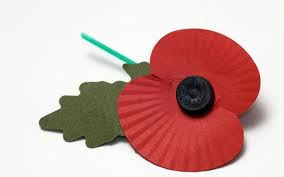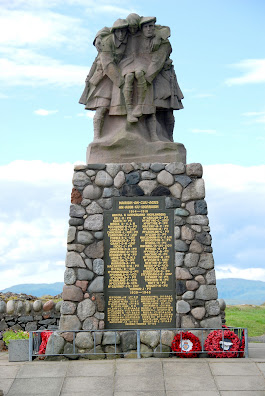War Memorials give no more than a name, yet they are one of the most
powerful, poignant and emotive of family history resources, recording
the loss of often young lives under harrowing circumstances. War
Memorials are not only significant features for the family, they also for the local community bear
witness to the sacrifice of their people in war.
Here you will find war memorials from across Britain, ranging from simple crosses to the imposing national monument.
The simple but moving monument on the Isle of Iona off western Scotland, looks across the water to the Isle of Mull.
Comrades in arms on the war memorial at Oban on the west coast of Scotland. It is in a most beautiful
peaceful setting, with a background of sea and hills over the Isle of
Mull - far removed from the horrors of war.
The memorial in the small village of Taynuilt near Oban.
On the Isle of Arran.
Another Scottish soldier portrayed on the war memorial at Aberfeldy, in Perthshire.
The Commando Memorial at Spean Bridge in the Scottish Highlands overlooks the training areas of the Commando Training Depot established in 1942 at Achnacarry Castle.
From the Highlands of Scotland to the Scottish Borders
The imposing war memorial in Hawick, The setting is Wilton Lodge
Park, a former 107 acre estate of the Pringle family, whose home is now
the town museum, displaying illuminated rolls of honour of the war
dead.
The War Memorial in the small village of Minto, near Hawick
Earlston War Memorial in the rural Scottish Borders, where I now live.
To England
A peaceful parkland setting for the war memorial in Clitheroe, Lancashire
Few families in the land could have escaped the impact of two World Wars, and my own was no exception.
The War Memorial in the Square at Poulton-le-Fylde, Lancashire, home of my mother's Danson family, with St. Chad's Church in the background.
My two great uncles - George Danson, a stretcher bearer in the field, who was killed on the Somme in 1916 a week after his 22nd birthday, and widower John Danson who died in Army training in 1917, leaving his young daughter an orphan.
.
The reality of war faced by so many families is epitomized in these two photograph
of George' Danson's grave, the one on the left sent to his widowed mother Maria Danson. It conveys
in a stark way the horrors of mud and blood that our ancestors must
have experienced and contrasts with the pristine white of the more
lasting memorials that we recognize today.
Also remembering my paternal great uncle Arthur William Matthews of
Wolverhampton, Staffordshire, who died at Gallipoli in 1915, leaving a widow and
four young children. Also Frederick Donaldson, my husbands
great uncle, killed on the Somme, in 1916, the same day as George
above, and remembered on the Thiepval Monument in Picardy, France, dedicated to men with no known grave.
National Memorials
The Battle of Britain Memorial on the Embankment in London
The Cenotaph, Britain's national memorial on Whitehall - photograph taken on a visit to London in November shortly after Remembrance Day.
The
Cenotaph began as a temporary structure erected for a peace
parade following the end of the First World War but following an
outpouring of national sentiment, it was replaced in 1920 by a permanent
structure and designated the United Kingdom's primary national war
memorial.
Designed by Edwin Lutyens and built of Portland Stone, the memorial was unveiled by King George V on 11 November 1920, the second anniversary of the end of the war. The unveiling ceremony for the Cenotaph was part of a larger procession bringing the Unknown Solider to be laid to rest in his tomb in Westminster Abbey.
The term "Cenetaph" relates to a monument to honour those who died, whose bodies are buried elsewhere or have no known grave.
Copyright © 2021 · Susan Donaldson. All Rights Reserved
******************************





















No comments:
Post a Comment
I very much look forward to reading your comment. Thank You.